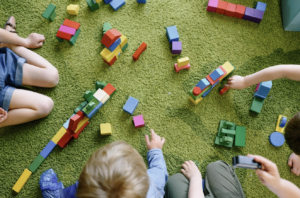What is Visual Perception and Why Does it Matter for Your Child?
 As a paediatric occupational therapist, I often see children who have difficulty processing and making sense of the visual information around them. While many people might assume that visual perception is just about how well we can see, it’s actually much more complex.
As a paediatric occupational therapist, I often see children who have difficulty processing and making sense of the visual information around them. While many people might assume that visual perception is just about how well we can see, it’s actually much more complex.
Visual perception refers to the brain’s ability to interpret and understand what we see.
It’s a vital skill for so many daily activities—everything from reading a book to catching a ball or even playing with friends.
In this post, I’ll break down the different areas of visual perception, explain why they’re so important, and how they impact both everyday tasks.
The Key Areas of Visual Perception
-
 Visual Discrimination
Visual Discrimination
This is the ability to distinguish between different objects based on size, shape, color, and pattern. Imagine your child trying to tell the difference between a ‘6’ and a ‘9’ in math, or recognizing the difference between a lowercase ‘b’ and a ‘d’ when reading. Visual discrimination is critical for reading, writing, and even understanding their environment.
- Visual Memory
This is the ability to remember and recall visual information. For example, a child needs strong visual memory to remember the shapes of letters or words, or to recall what they’ve seen in a picture or a story. Struggling with this can make it harder for them to follow directions or retain information, like remembering the sequence of a math problem.
- Figure-Ground Perception
Children with challenges in figure-ground perception may have difficulty focusing on relevant visual information in a busy or cluttered background. For instance, a child might struggle to find their favorite toy in a messy room or lose their place when reading a page filled with text. This skill is crucial for reading, completing schoolwork, and even finding things at home.
- Form Constancy
This skill helps a child recognize an object even when its size, shape, color, or position changes. For example, if a child sees the letter ‘T’ in one font and then in another, they should be able to identify it as the same letter. Form constancy is also important for tasks like sorting objects, recognizing words, and handwriting.
-
 Visual Closure
Visual Closure
Visual closure is the ability to recognize an object or word even when it’s incomplete. For example, if you show a child a picture of a cat with only part of its body visible, they should still be able to identify it. This skill is crucial for reading fluency.
- Visual Spatial Relationships
This is the ability to understand how objects relate to one another in space. For instance, understanding how far apart objects are or how to judge distance when throwing a ball. It also plays a role in understanding directions like ‘up,’ ‘down,’ ‘left,’ and ‘right.’
- Visual Attention
Visual attention is the ability to focus on relevant visual information and ignore distractions. Without strong visual attention, a child might miss important details, like not noticing a red light when crossing the street, or losing focus when reading or completing a task.
-
 Visual Motor Integration
Visual Motor Integration
This skill combines visual perception and motor coordination ensuring our eyes and hands work together in a coordinated manner. It’s crucial for tasks like handwriting, cutting, drawing, and even playing sports. Without good visual-motor integration, tasks that involve fine motor skills can become very challenging.
How Visual Perception Impacts Daily Life
Visual perception isn’t just important for academic tasks; it affects almost every part of a child’s life, both at home and in social settings.
If you notice that your child consistently struggles with tasks related to visual perception, such as reading, handwriting, or navigating space, it might be time to seek help from an occupational therapist. An OT can assess your child’s visual perceptual skills and recommend specific strategies and activities to help improve these skills.
Visual perception is a vital skill for every aspect of a child’s development. Whether it’s reading, playing, or navigating their environment, visual perception is the foundation that helps them understand the world around them. If your child is struggling, it’s important to address it early to ensure they have the support they need to thrive, both at home and at school
Remember, if you suspect your child is having difficulty with visual perception, don’t hesitate to reach out to an optometrist for a vision test or an occupational therapist for further evaluation and support. If you would like further information regarding therapy or the intervention process, please don’t hesitate to get in touch with our Occupational Therapists via [email protected] or call us at the clinic on (07) 3265 4495.

Written by Helena Manicaros, 2025 (Occupational Therapist), June 2025
References:
-
Beery, K. E., & Beery, N. A. (2010). The Beery-Buktenica Developmental Test of Visual-Motor Integration (6th ed.). Pearson Education.
-
Hammill, D. D., Pearson, N. A., & Voress, J. K. (2013). Developmental Test of Visual Perception (3rd ed.). Western Psychological Services.
